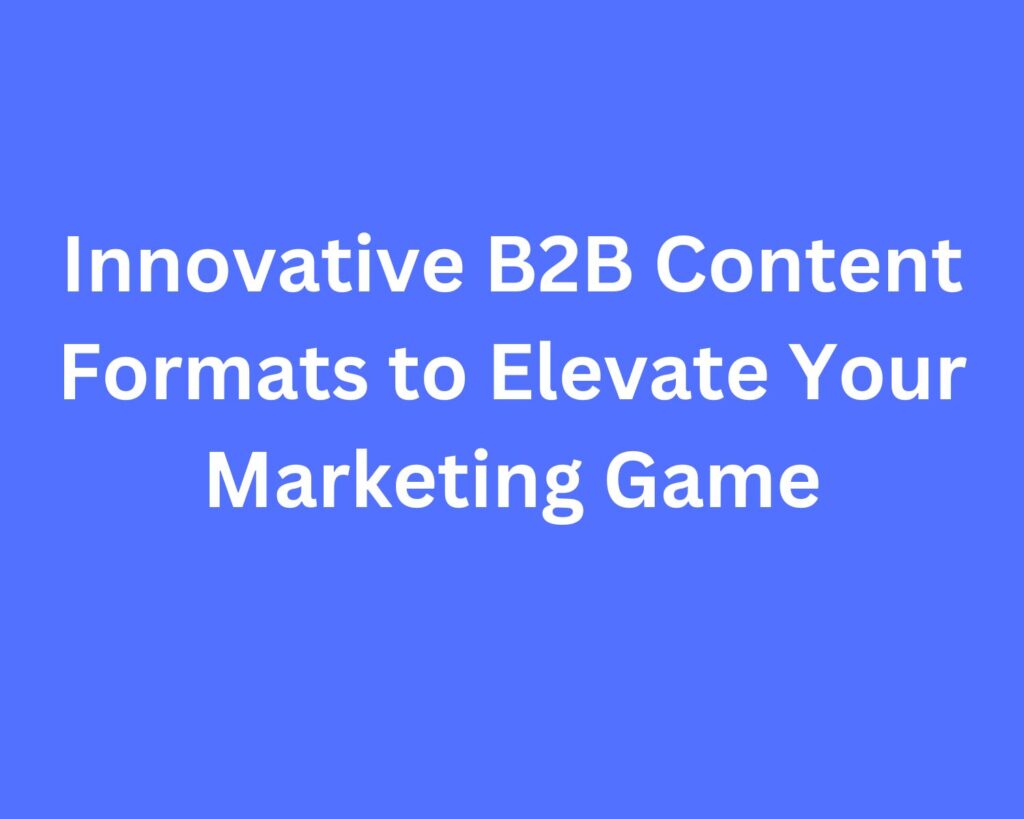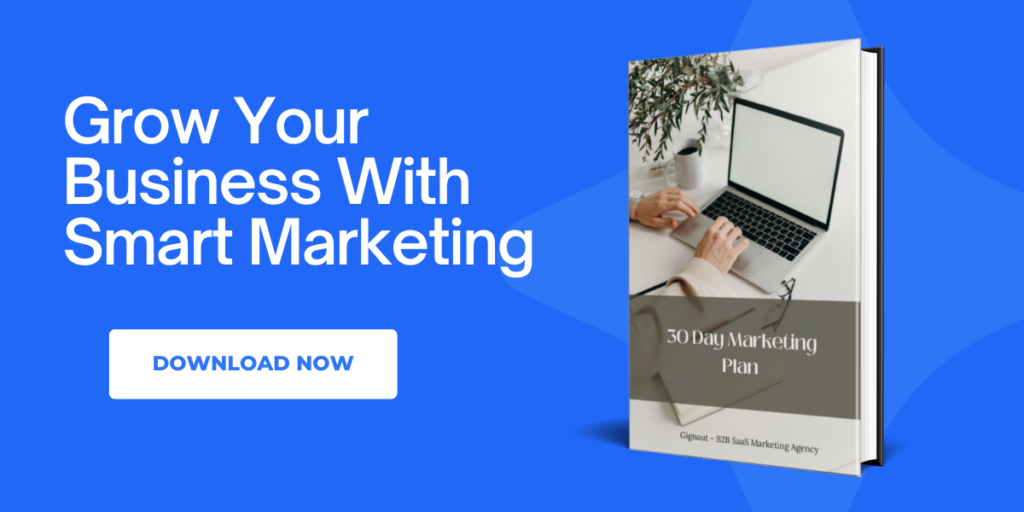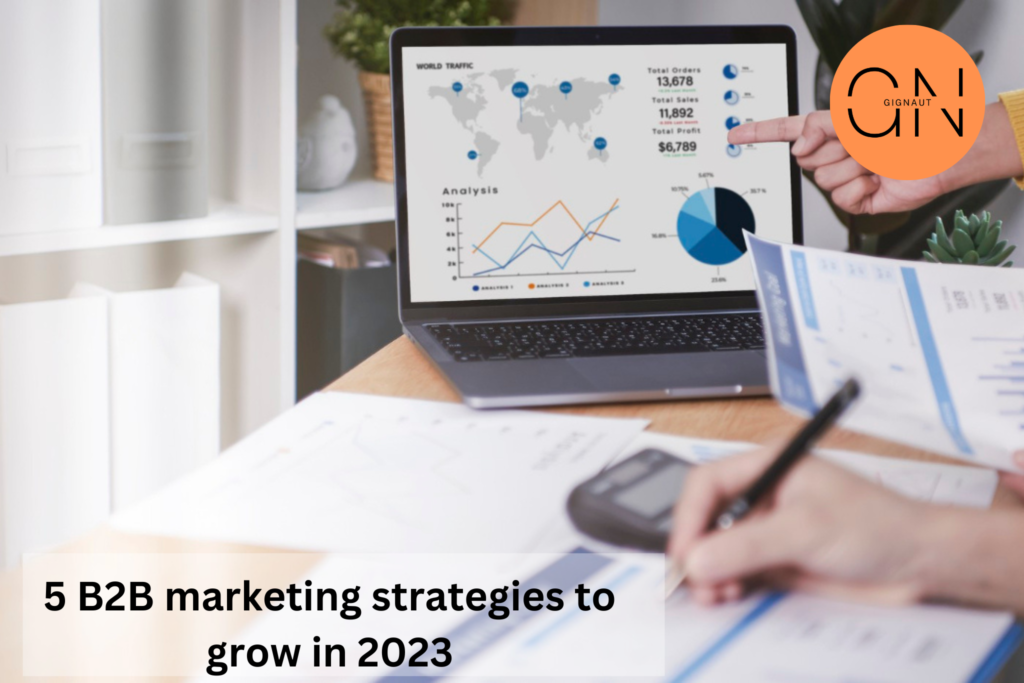Nowadays, it’s absolutely essential for businesses to have a killer content strategy to succeed. But here’s the thing – the same old content formats that used to work like a charm might not be doing the trick anymore.
Why’s that? Well, B2B audiences are evolving, and they’ve got new preferences and expectations. It’s getting harder to grab their attention and turn them into loyal customers using traditional methods alone. That’s why it’s time to shake things up and get creative with some innovative content formats that’ll blow their minds!
In this blog, we’re diving into the exciting world of B2B content innovation. We’ll show you why it’s so crucial to stay ahead of the game and how you can do it by adopting fresh and captivating formats. Get ready to revitalize your content strategy with these cutting-edge approaches that are transforming the entire industry! Let’s dive in!
Why Traditional Content Formats May Not Be Enough?
As the B2B marketing landscape becomes increasingly crowded, standing out from the competition has become a significant challenge. While blog posts, whitepapers, and eBooks have been valuable staples in content marketing, they might not leave a lasting impact on today’s discerning audience. B2B buyers are now seeking fresh, interactive, and immersive experiences that provide real value and address their pain points. To resonate with modern B2B audiences, marketers need to adapt and leverage innovative formats that capture attention and foster engagement.
The Changing Preferences of B2B Audiences
The B2B buying audience is rapidly shifting, with millennials and Gen Z making up a substantial portion of the market. These digital natives have grown up in a world of interactivity and personalization, and their preferences reflect this. To effectively connect with these tech-savvy buyers, B2B marketers must adjust their strategies and embrace innovative content formats that cater to these evolving preferences. By meeting the audience where they are, businesses can establish authentic connections and build brand loyalty.
Exploring Innovative B2B Content Formats
1. Interactive Infographics: Engaging Through Data Visualization
Interactive infographics offer a dynamic and engaging way to present complex data. By enabling users to interact with the information, businesses can provide a more personalized experience. These visual narratives make it easier for prospects to understand data-driven insights and can be a powerful tool for communicating a brand’s value proposition.
2. Virtual Events and Webinars: Driving Real-Time Interactions
In the era of remote work and digital connectivity, virtual events and webinars have gained immense popularity. These formats allow businesses to connect with their audience in real-time, fostering direct interactions through Q&A sessions, live demos, and networking opportunities. Virtual events are cost-effective and enable companies to reach a global audience, thereby increasing engagement and lead generation.
3. Augmented Reality (AR) Experiences: Elevating Product Demonstrations
Augmented Reality has revolutionized the way B2B companies showcase their products and services. By offering virtual, interactive product demonstrations, businesses can provide prospects with immersive experiences. AR allows potential customers to visualize products in real-world scenarios, enhancing their understanding and making the decision-making process more informed and confident.
4. Podcasting: Leveraging the Power of Audio Content
Podcasting has emerged as a powerful medium for B2B companies seeking to establish thought leadership and connect with their audience on a deeper level. Through engaging interviews, discussions, and expert insights, podcasts offer a unique opportunity to deliver valuable content to busy professionals. Audio content is convenient for on-the-go consumption, making it an ideal choice for busy B2B decision-makers.
5. User-Generated Content (UGC) Campaigns: Fostering Brand Advocacy
User-generated content (UGC) campaigns harness the power of satisfied customers and brand advocates. By encouraging customers to share their experiences, testimonials, and success stories, businesses can build trust and authenticity while extending their reach. UGC resonates well with potential buyers as it comes from real customers who have experienced the brand’s offerings firsthand.
Integrating Innovative Formats into Your B2B Content Strategy:
To successfully incorporate innovative content formats into your B2B marketing strategy, follow these steps:
1. Assess Your Target Audience and Content Objectives
Understand your audience’s preferences, pain points, and content consumption habits. Align your content objectives with your overall marketing goals to create a cohesive and effective strategy.
2. Choose the Right Formats to Align with Your Brand Message
Select formats that align with your brand identity and the nature of your products or services. Ensure that the chosen formats resonate with your target audience and effectively convey your key messages.
3. Create a Cohesive and Consistent Content Plan with a Mix of Formats
Strike a balance between various content formats to maintain your audience’s interest and prevent content fatigue. Develop a content calendar that outlines when and how you’ll deploy each format to maximize their impact.
Measuring Success: Tracking and Analyzing Innovative Content Performance:
Effectively measuring the success of innovative content formats is vital to refining your strategy and optimizing future campaigns. Consider the following steps:
1. Identify Relevant Metrics for Each Format
Determine key performance indicators (KPIs) for each content format, such as engagement rates, time spent, conversion rates, and lead generation. These metrics will provide insights into the effectiveness of your content and guide future improvements.
2. Utilize Tools and Platforms for Monitoring and Analytics
Leverage analytics tools and platforms to track and analyze the performance of your content formats. Google Analytics, social media insights, and marketing automation software can provide valuable data to help you understand your audience better.
3. Make Data-Driven Decisions to Optimize Future Campaigns
Use the insights gained from analytics to make data-driven decisions in your SaaS marketing campaigns and optimize your content strategy continually. By understanding what works and what doesn’t in your SaaS marketing campaigns, you can refine your approach to deliver more engaging and valuable content to your audience.
Overcoming Challenges in Implementing Innovative Content Formats
Implementing innovative content formats may present some challenges. Here’s how to overcome them:
1. Budget Constraints and Resource Allocation
Innovative formats may require additional resources and investments. Allocate your budget wisely and consider collaborating with external partners to make the most of your available resources.
2. Addressing Technological Barriers and Learning Curves
Adopting new technologies can be intimidating, but it’s essential to stay ahead in the digital landscape. Invest in employee training and stay informed about emerging technologies to adapt and succeed.
3. Mitigating Risks and Aligning with Company Stakeholders
Innovative content formats might involve risks, especially when pushing the boundaries of traditional approaches. Seek buy-in from relevant stakeholders, and demonstrate the potential benefits and ROI to gain support for your endeavors.
Case Studies of B2B Companies Excelling with Innovative Content
To provide further inspiration, let’s explore the case studies of B2B companies that have achieved success with innovative content formats:
1. Interactive infographic
Case Study 1: Siemens Healthineers – “COVID-19 Impact on Medical Imaging Trends” Siemens Healthineers, a global medical technology company, wanted to educate healthcare professionals about the impact of the COVID-19 pandemic on medical imaging trends. They created an interactive infographic that showcased data on changes in medical imaging utilization, patient volumes, and equipment demand during the pandemic.
The interactive format allowed users to explore data based on specific regions, medical facilities, and imaging modalities. The engaging nature of the infographic attracted healthcare professionals seeking insights into adapting their practices during the crisis. Siemens Healthineers experienced a significant increase in website traffic and a 25% improvement in lead generation from medical professionals interested in their solutions.
2. Virtual Events and Webinars
Case Study 2: Salesforce – “Dreamforce to You” Salesforce, a leading customer relationship management (CRM) platform, typically hosts their annual in-person conference, Dreamforce, with thousands of attendees. However, due to the COVID-19 pandemic, hosting a physical event was not possible.
Salesforce quickly adapted and hosted “Dreamforce to You,” a virtual event with interactive webinars, product demos, and live Q&A sessions. Attendees from around the world could access the event from the comfort of their homes or offices. This innovative approach allowed Salesforce to connect with a global audience, resulting in a 40% increase in attendance compared to their previous in-person events. The virtual event also led to a 15% boost in qualified leads, demonstrating the success of virtual engagement strategies.
3. Augmented Reality (AR) Experiences
Case Study 3: Volvo Trucks – “Reality Roadshow” Volvo Trucks, a leading manufacturer of commercial vehicles, wanted to provide potential customers with an immersive experience to showcase the safety features and capabilities of their new truck models.
They launched the “Reality Roadshow,” where potential customers could experience augmented reality demonstrations of Volvo trucks’ safety features, such as automatic braking and adaptive cruise control. Using their smartphones or tablets, visitors could virtually test drive the trucks and witness firsthand how these safety features worked in real-world scenarios.
The AR experience generated significant buzz and increased foot traffic to Volvo Trucks’ showrooms and events. The campaign resulted in a 50% increase in test drives booked during the roadshow period, contributing to a boost in truck sales and market share.
4. Podcasting
Case Study 4: HubSpot – “The Growth Show” HubSpot, a leading inbound marketing and sales software company, launched a podcast series called “The Growth Show.” The podcast featured interviews with industry leaders, entrepreneurs, and experts who shared insights on business growth, marketing strategies, and leadership.
By tapping into the popularity of podcasts, HubSpot successfully established thought leadership and engaged its audience in a new way. “The Growth Show” became a hit among marketers and business professionals seeking valuable insights to drive growth. The podcast significantly increased website traffic, with a 30% rise in inbound leads from podcast listeners.
5. User-Generated Content (UGC) Campaigns
Case Study 5: Starbucks – “White Cup Contest” Starbucks, the world-famous coffee chain, launched the “White Cup Contest,” encouraging customers to get creative and doodle on their plain white coffee cups. Customers were then asked to share their cup designs on social media with the hashtag #WhiteCupContest.
The UGC campaign went viral, with thousands of customers sharing their artistic creations. The contest generated significant social media buzz, resulting in a 25% increase in social media engagement and a 15% rise in foot traffic to Starbucks stores. The campaign showcased Starbucks’ commitment to engaging with their customers and amplified brand advocacy among coffee enthusiasts.
Looking Ahead: Predictions for the Future of B2B Content Marketing
As technology continues to advance and audience preferences evolve, several trends are likely to shape the future of B2B content marketing:
1. Continued Growth of Interactive and Immersive Formats
Interactive and immersive formats, such as virtual reality (VR) and 360-degree experiences, are likely to become even more prevalent. These technologies will offer unique opportunities for businesses to engage with their audience on a deeper level, providing unparalleled brand experiences.
2. Personalization and Data-Driven Content
B2B marketers will increasingly rely on data-driven insights to create personalized content experiences. Using advanced analytics and artificial intelligence, businesses can deliver tailored content that resonates with individual prospects, fostering stronger connections and higher conversion rates.
Conclusion:
Innovative content formats hold the key to revolutionizing B2B content marketing. By embracing interactivity, personalization, and immersive experiences, businesses can create stronger connections with their audience and drive better results. Whether it’s through interactive infographics, virtual events, AR experiences, podcasts, or user-generated content campaigns, the possibilities are limitless.
To stay ahead in today’s competitive landscape, B2B companies must stay agile, adapt to changing preferences, and embrace creativity in their content strategy. By harnessing the power of innovation, you can create meaningful experiences that leave a lasting impact on your audience, build brand loyalty, and drive business growth.
It’s time to unleash the power of innovative formats and transform your B2B content marketing strategy into an engaging and successful journey! So, go ahead, take the leap, and be a trailblazer in the world of B2B content marketing!
Get in touch with the Gignaut team today to start measuring and improving your marketing efforts.
Check the B2B SaaS Marketing Handbook to learn more.






